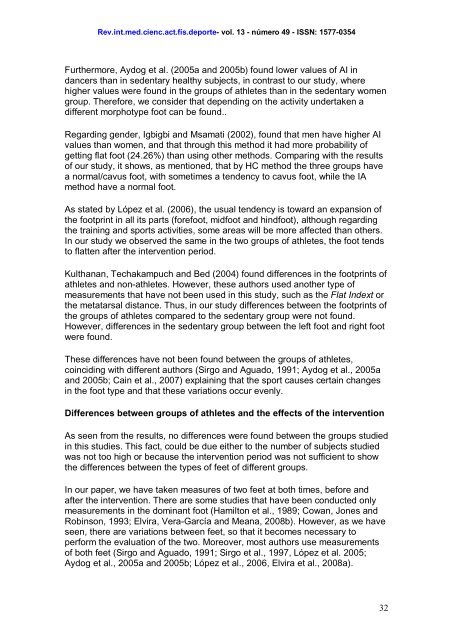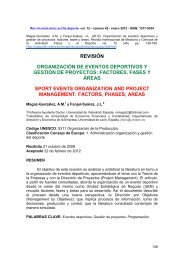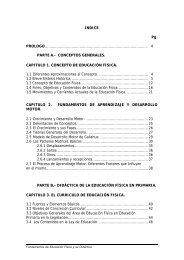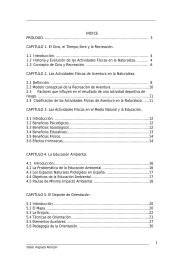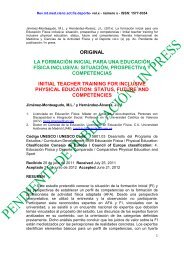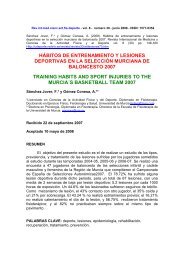English - Comunidad Virtual CIENCIAS DEL DEPORTE - RedIRIS
English - Comunidad Virtual CIENCIAS DEL DEPORTE - RedIRIS
English - Comunidad Virtual CIENCIAS DEL DEPORTE - RedIRIS
Create successful ePaper yourself
Turn your PDF publications into a flip-book with our unique Google optimized e-Paper software.
Rev.int.med.cienc.act.fís.deporte- vol. 13 - número 49 - ISSN: 1577-0354<br />
Furthermore, Aydog et al. (2005a and 2005b) found lower values of AI in<br />
dancers than in sedentary healthy subjects, in contrast to our study, where<br />
higher values were found in the groups of athletes than in the sedentary women<br />
group. Therefore, we consider that depending on the activity undertaken a<br />
different morphotype foot can be found..<br />
Regarding gender, Igbigbi and Msamati (2002), found that men have higher AI<br />
values than women, and that through this method it had more probability of<br />
getting flat foot (24.26%) than using other methods. Comparing with the results<br />
of our study, it shows, as mentioned, that by HC method the three groups have<br />
a normal/cavus foot, with sometimes a tendency to cavus foot, while the IA<br />
method have a normal foot.<br />
As stated by López et al. (2006), the usual tendency is toward an expansion of<br />
the footprint in all its parts (forefoot, midfoot and hindfoot), although regarding<br />
the training and sports activities, some areas will be more affected than others.<br />
In our study we observed the same in the two groups of athletes, the foot tends<br />
to flatten after the intervention period.<br />
Kulthanan, Techakampuch and Bed (2004) found differences in the footprints of<br />
athletes and non-athletes. However, these authors used another type of<br />
measurements that have not been used in this study, such as the Flat Indext or<br />
the metatarsal distance. Thus, in our study differences between the footprints of<br />
the groups of athletes compared to the sedentary group were not found.<br />
However, differences in the sedentary group between the left foot and right foot<br />
were found.<br />
These differences have not been found between the groups of athletes,<br />
coinciding with different authors (Sirgo and Aguado, 1991; Aydog et al., 2005a<br />
and 2005b; Cain et al., 2007) explaining that the sport causes certain changes<br />
in the foot type and that these variations occur evenly.<br />
Differences between groups of athletes and the effects of the intervention<br />
As seen from the results, no differences were found between the groups studied<br />
in this studies. This fact, could be due either to the number of subjects studied<br />
was not too high or because the intervention period was not sufficient to show<br />
the differences between the types of feet of different groups.<br />
In our paper, we have taken measures of two feet at both times, before and<br />
after the intervention. There are some studies that have been conducted only<br />
measurements in the dominant foot (Hamilton et al., 1989; Cowan, Jones and<br />
Robinson, 1993; Elvira, Vera-García and Meana, 2008b). However, as we have<br />
seen, there are variations between feet, so that it becomes necessary to<br />
perform the evaluation of the two. Moreover, most authors use measurements<br />
of both feet (Sirgo and Aguado, 1991; Sirgo et al., 1997, López et al. 2005;<br />
Aydog et al., 2005a and 2005b; López et al., 2006, Elvira et al., 2008a).<br />
32


